Quantum entanglement, a phenomenon once deemed “spooky” by Einstein, is now a pivotal element in the development of quantum computers, enabling capabilities beyond classical computing. Recent research has achieved a significant milestone by demonstrating entanglement between atomic nuclei separated by approximately 20 nanometers, a distance that aligns with the fabrication scale of conventional silicon transistors. This breakthrough not only enhances the potential for integrating atomic qubits into existing silicon chip architectures but also addresses the critical challenge of balancing the need for operational control with shielding from noise, a persistent issue in quantum computing hardware.
The innovative approach employs electrons as intermediaries, allowing distant atomic nuclei to communicate effectively, akin to using telephones to connect individuals in separate rooms. By utilizing a method known as the “geometric gate,” researchers have successfully scaled entanglement beyond pairs of nuclei linked to a single electron. This advancement opens pathways for constructing quantum computers that leverage long-lived nuclear spins, promising reliable computations while fitting seamlessly into the current technological landscape of silicon-based devices. The implications of this work could accelerate the transition from theoretical quantum models to practical applications in computing.








